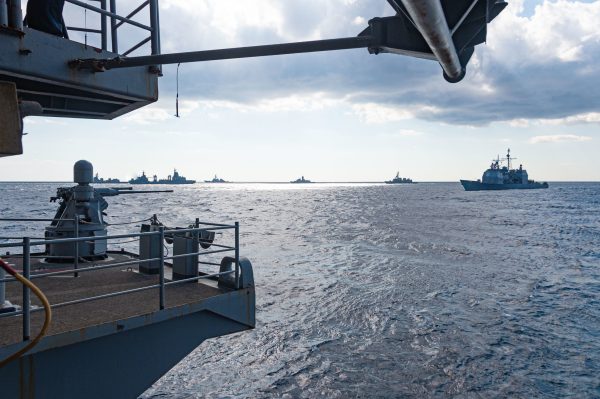
The militaries of the Quad — Australia, India, Japan, and the United States — conducted the joint Malabar exercise off the coast of Japan in November. The exercise came against the backdrop of not only China’s aggressive behavior but also increased belligerence from North Korea, which has conducted more ballistic missile tests in 2022 than in any previous year. The four participating countries have more in common in terms of their strategic goals for the Indo-Pacific region as well as their desire to gain greater operational efficiency through better integration.
This edition marked the 30th anniversary of the Malabar exercises that began between India and the United States in 1992. It expanded to include Japan as a permanent partner since 2015. From 2020 onward, Exercise Malabar has seen the participation of the Australian Navy as well. This is the third edition in a row that has involved the participation of the Australian Navy in the Malabar exercise.
In February 2021, responding to a question in the Parliament on the Malabar exercise after Australia’s inclusion, Indian Minister of State for Defense Shripad Naik said, “The exercises highlight the convergence of views among the participating countries on maritime issues and their shared commitment to an open, inclusive Indo-Pacific and a rules-based international order.” The exercise brings together the four Quad countries with a sense of purpose of ensuring a free and open Indo-Pacific.
Indian Chief of Naval Staff Admiral Hari Kumar was in Japan for the inauguration of the 2022 edition of the Malabar exercise. According to a press release from the Indian Ministry of Defense, the Indian navy chief was in Japan for a couple of additional engagements as well, including witnessing the International Fleet Review held by the Japan Maritime Self-Defense Force (JMSDF) and celebrating the 7oth anniversary of the IFR, as well as to participate in the Western Pacific Naval Symposium (WPNS) as an Observer Navy. Kumar also used the opportunity to meet with his counterparts from almost 30 countries that are participating in the IFR, WPNS, and the Malabar exercise. These meetings have become an excellent opportunity for the Indian Navy to engage in broader outreach and strategic engagements.
On the Indian side, two indigenously-developed ships participated, the INS Shivalik, a stealth frigate, and INS Kamorta, an anti-submarine warfare (ASW) corvette. The group was led by Rear Admiral Sanjay Bhalla, Flag Officer Commanding the Eastern Fleet. The two ships also participated in the International Fleet Review. India also sent a P-8I long-range maritime patrol aircraft for the annual exercise.
The U.S. Navy sent its nuclear-powered aircraft carrier USS Ronald Reagan, guided missile cruiser USS Chancellorsville, and Aegis-guided missile destroyer USS Milius; Australia deployed its Anzac-class frigate Arunta and tanker Stalwart; and Japan had its helicopter carrier Hyuga, destroyers Takanami and Shiranui, and tanker Oumi.
The Indian Navy spokesperson in a tweet said that “the sea phase witnessed live wpn [weapon] firings, surface, anti-air & anti-submarine warfare drills & tactical procedures.” Upon the culmination of the Malabar exercise on November 15, the Indian Ministry of Defense issued a press release highlighting that one of the major features of the exercise was “the conduct of War at Sea exercise which enabled all four navies to consolidate interoperability and hone their tactical skills.”
The statement further said that “the high-tempo exercise saw the participation of eleven surface ships including a nuclear powered aircraft carrier with its integral air elements, along with four long-range maritime patrol aircraft, integral helicopters and two submarines. The exercise also involved exchange of ‘Sea Riders’ between various participating ships.”
The exercise also validated the participating countries’ different logistics support agreements signed at bilateral levels. These exercises have proven to be enormously useful in producing a better understanding of each other’s operational methodologies and their skill sets to cooperate effectively while handling a variety of maritime challenges in the Indo-Pacific.
Meanwhile, it has been a busy few months for the Indian military.
Indian and U.S. Joint Special Force Exercise Vajra Prahar 2022 concluded in Himachal Pradesh on August 28. According to an Indian Ministry of Defense statement, the 13th edition of this exercise included a 21-day joint program “to train in Air Borne Operations, Special Operations and Counter Terrorism operations in a joint environment under United Nations Charter.” The statements noted the “immense satisfaction” expressed by both sides in terms of “the standards achieved and sharing of best practices, when both contingents undertook joint training, planning and execution of a series of mock operations in simulated conventional and unconventional scenarios in mountainous terrain.”
The Indian and U.S. armies just concluded their annual military exercise, Yudh Abhyas, at Auli in Uttarakhand, a state that borders China along the Line of Actual Control. U.S. Army soldiers from the 2nd Brigade of the 11th Airborne Division and Indian Army soldiers from the Assam Regiment took part in the exercise. According to an Indian Ministry of Defense press release, the Field Training Exercise part of Yudh Abhyas included “validation of integrated battle groups, force multipliers, establishment and functioning of surveillance grids, validation of operational logistics, mountain warfare skills, casualty evacuation and combat medical aid in adverse terrain and climatic conditions.” There were also “exchanges and practices on a wide spectrum of combat skills including combat engineering, employment of UAS/Counter UAS techniques and information operations,” all of which meant “to share their wide experiences, skills and enhance their techniques through information exchange.”
Meanwhile, the Indian and Australian armies are engaged in their inaugural round of bilateral exercise, Austra-Hind in Rajasthan from November 28 to December 11.
Clearly, the Indian eagerness to partner with the Quad countries in joint military exercises is evident. Given the continuing tensions with China, India will continue to expand these military engagements and security consultations for more coordinated military activities in the region in order to ensure a stable and secure Indo-Pacific.
Malabar and More: Quad Militaries Conduct Exercises
Source: Frappler

0 Comments